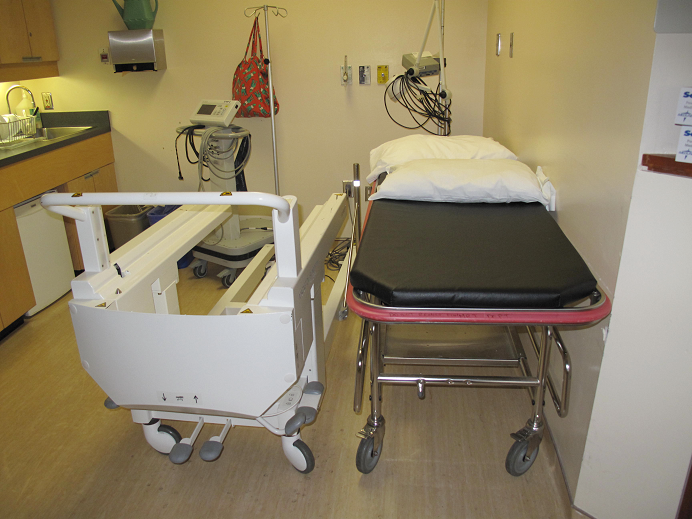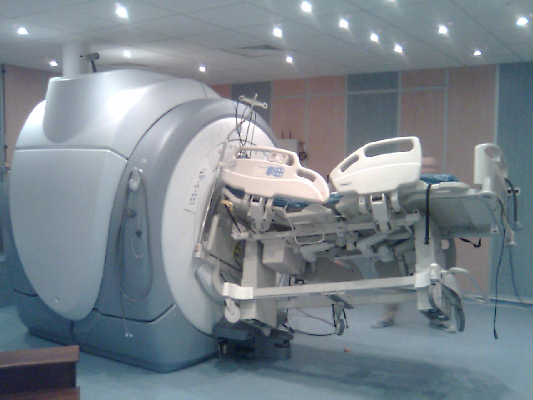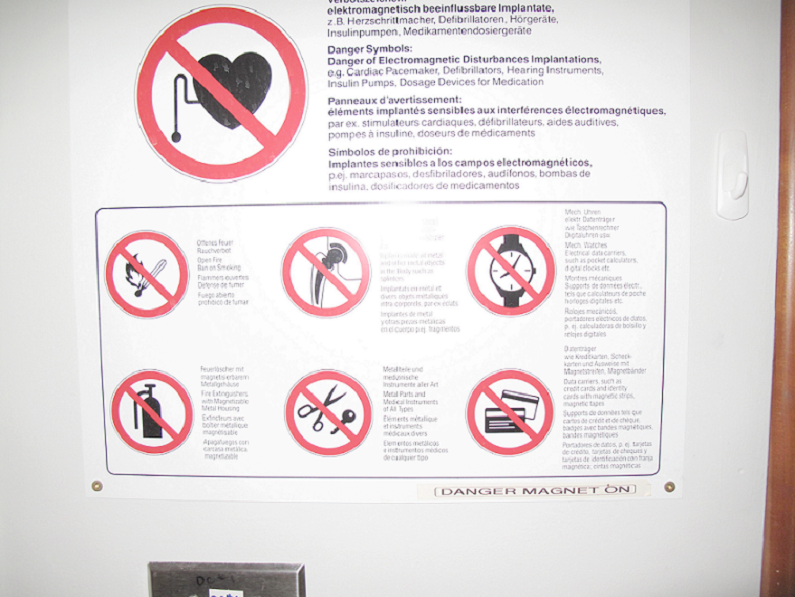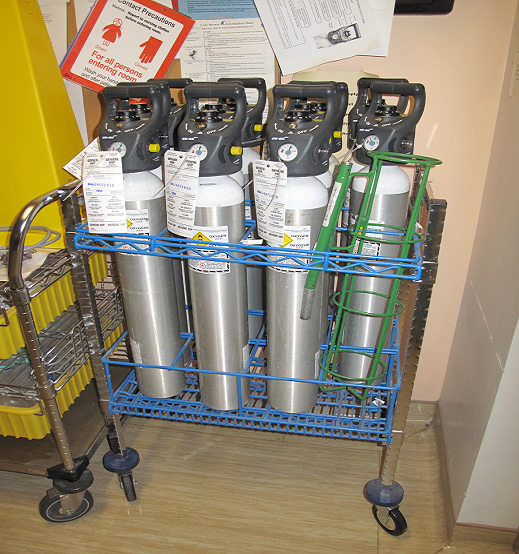Diagnostic Imaging (Hgh) - MRI Safety Quiz

In MRI, if you aren't aware of the safety protocols, people can, and most likely will, get hurt.
This is a review of general, but EXTREMELY important, MRI safety. Although most of us don't work in MRI, we could be asked to help with a transfer or even in a Code Blue situation. This is why it has been added to our yearly departmental review. If you don't know the answers. . . Please visit the lovely staff in MRI and they would be more than happy to help you.
- 1.
When does a patient need their pre-MRI orbit x-rays done?
- A.
If the patient HAS worked with metal and they are not 100% sure that they have never had metal go in their eye.
- B.
If the patient HAS had a piece of metal in their eye and they are not 100% sure that the Doctor did remove it all. (ie. did not have orbits done after to confirm 100% removal)
- C.
If the patient is unconscious and no CT head (that demonstrated orbits well) has been done recently.
- D.
All of the above.
Correct Answer
D. All of the above.Explanation
Pre-MRI orbit x-rays are necessary in all the given scenarios. If a patient has worked with metal and is unsure if any metal has entered their eye, pre-MRI orbit x-rays are needed to ensure there is no metal present that could cause harm during the MRI. Similarly, if a patient has had a piece of metal in their eye and is unsure if it has been completely removed, pre-MRI orbit x-rays are necessary to confirm removal. Lastly, if a patient is unconscious and a recent CT head scan that clearly showed the orbits has not been done, pre-MRI orbit x-rays are needed to assess the condition of the orbits.Rate this question:
-
- 2.
Why is is so important that the MRI scanner be locked after hours?
- A.
The magnet is always on and having the room accessible when no one is around is a MAJOR safety issue.
- B.
How else is Sandy supposed to get some peace and quiet while drinking her tea.
- C.
Ear plugs cost a lot of money and they have been know to go missing.
Correct Answer
A. The magnet is always on and having the room accessible when no one is around is a MAJOR safety issue.Explanation
The MRI scanner uses a strong magnetic field to create images of the body. This magnetic field can be dangerous if not properly controlled. If the room is accessible when no one is around, there is a risk of unauthorized access or tampering with the equipment, which can lead to accidents or damage. Locking the room ensures that only authorized personnel can access the scanner, reducing the risk of safety issues.Rate this question:
-
- 3.
Why is a Code Blue different in MRI compared to anywhere else in the hospital?
- A.
Because of the remoteness of the area.
- B.
Pager and Cell phones don't work in MRI.
- C.
Most staff are unaware of the importance of MRI safety and don't realize that the patient cannot be cared for inside the MRI scanner room.
Correct Answer
C. Most staff are unaware of the importance of MRI safety and don't realize that the patient cannot be cared for inside the MRI scanner room.Explanation
The correct answer explains that a Code Blue in an MRI is different compared to anywhere else in the hospital because most staff are unaware of the importance of MRI safety and don't realize that the patient cannot be cared for inside the MRI scanner room. This suggests that there is a lack of knowledge and understanding among the staff regarding the unique safety protocols and requirements in an MRI setting. As a result, there may be delays or challenges in providing immediate medical assistance to a patient experiencing a medical emergency inside the MRI scanner room.Rate this question:
-
- 4.
If the patient 'codes' in the scanner, does the Code Team come into the scan room to care for the patient?
- A.
Yes. There is no difference in how the Code team cares for the patient in the MRI scan room.
- B.
No. This is a major safety risk. When a Code blue is called, the patient must be removed from the scanner with the use of MRI compatible stretchers. They are then brought out into the pt holding area to allow for safe treatment from the Code Team. The scanner door must also be locked to ensure other staff does not enter the room during the Code.
Correct Answer
B. No. This is a major safety risk. When a Code blue is called, the patient must be removed from the scanner with the use of MRI compatible stretchers. They are then brought out into the pt holding area to allow for safe treatment from the Code Team. The scanner door must also be locked to ensure other staff does not enter the room during the Code. -
- 5.
If you are needed to assist staff in the MRI scan room you must:
- A.
Be careful and treat the area as if it is a sterile field.
- B.
Complete a MRI screening form to ensure that you are not putting yourself at risk by entering the scan room. If the scanning form clears you to enter the room, you may do so at that time.
- C.
Complete a MRI screening form to ensure that you are not putting yourself at risk by entering the scan room. If you are clear to go in, you must also remove all pagers, cell phones, badges, coins, pens, scissors, jewellery that isn't real gold or silver (non-ferromagnetic= not attracted to magnet) watches, credit cards, banks cards and anything else that is in your pockets. **Note** Digital watches may be worn because they are not afffected by the magnetic field.
Correct Answer
C. Complete a MRI screening form to ensure that you are not putting yourself at risk by entering the scan room. If you are clear to go in, you must also remove all pagers, cell phones, badges, coins, pens, scissors, jewellery that isn't real gold or silver (non-ferromagnetic= not attracted to magnet) watches, credit cards, banks cards and anything else that is in your pockets. **Note** Digital watches may be worn because they are not afffected by the magnetic field.Explanation
To assist staff in the MRI scan room, it is important to complete a MRI screening form to assess any potential risks. If the form clears you to enter the room, you must then remove all items that are sensitive to the magnetic field, such as pagers, cell phones, badges, coins, pens, scissors, and non-ferromagnetic jewelry (not attracted to magnets). Additionally, any items in your pockets, such as credit cards or bank cards, should be removed. However, digital watches are allowed as they are not affected by the magnetic field.Rate this question:
-
- 6.
Why is it important to NEVER remove the wheelchair and stretcher shown here from MRI ?
- A.
Because we all know how hard it is to find wheelchairs around here.
- B.
Because if anyone ever fainted, the staff need a place to lie patients down.
- C.
Because this stretcher and wheelchair are MRI compatible and they are the only ones that can actually enter the scan room safely.
Correct Answer
C. Because this stretcher and wheelchair are MRI compatible and they are the only ones that can actually enter the scan room safely.Explanation
The correct answer states that the stretcher and wheelchair shown are MRI compatible and are the only ones that can safely enter the scan room. This suggests that the MRI machine may have specific requirements or magnetic fields that could be dangerous or damaging to regular wheelchairs or stretchers. Therefore, it is important to never remove these specially designed MRI compatible equipment from the scan room.Rate this question:
-
- 7.
What do you think happened here?
- A.
Someone had a lot of paperwork to fill out!
- B.
This is a demonstration of what could happen if a regular bed was advanced, or even placed to close to the scan room. (Thankfully no one is in the bed)
- C.
OOOpppppsss.. I left the door to the room open :-(
Correct Answer
B. This is a demonstration of what could happen if a regular bed was advanced, or even placed to close to the scan room. (Thankfully no one is in the bed)Explanation
The given answer correctly explains that the situation depicted in the description is a demonstration of the potential consequences of moving or placing a regular bed too close to a scan room. It emphasizes that it is fortunate that no one is in the bed during this incident. The answer suggests that the cluttered paperwork and the open door may be contributing factors to the situation, although it does not explicitly state it.Rate this question:
-
- 8.
What is the #1 contraindication for patient's having an MRI?
- A.
Stents
- B.
Staples
- C.
Intramedullary Nails
- D.
Pacemakers
Correct Answer
D. PacemakersExplanation
Pacemakers are the #1 contraindication for patients having an MRI. This is because the strong magnetic field of the MRI machine can disrupt the functioning of the pacemaker and potentially cause harm to the patient. It is important to remove or disable the pacemaker before undergoing an MRI to ensure the safety of the patient.Rate this question:
-
- 9.
This could happen (check out this video) if one of the non-MRI compatible oxygen cylinders (shown above) enters the scan room. True or False?
- A.
True
- B.
False
Correct Answer
A. TrueExplanation
If one of the non-MRI compatible oxygen cylinders enters the scan room, it can cause a dangerous situation. MRI machines use strong magnetic fields, and any metal objects can become projectiles and cause serious harm to patients and staff. Therefore, it is true that this could happen if a non-MRI compatible oxygen cylinder enters the scan room.Rate this question:
-
Quiz Review Timeline +
Our quizzes are rigorously reviewed, monitored and continuously updated by our expert board to maintain accuracy, relevance, and timeliness.
-
Current Version
-
Mar 22, 2023Quiz Edited by
ProProfs Editorial Team -
Jul 23, 2009Quiz Created by
Sandragrollman
 Back to top
Back to top







